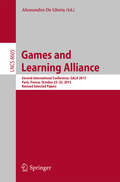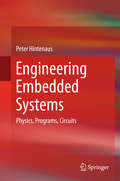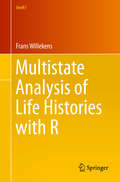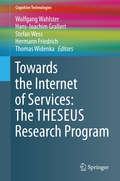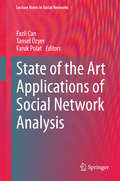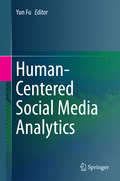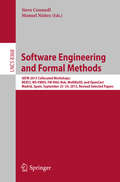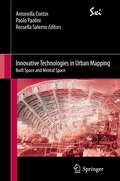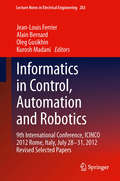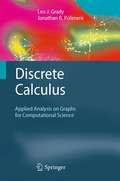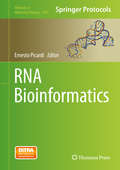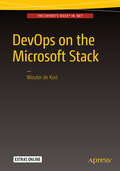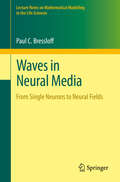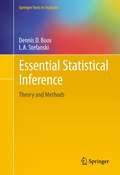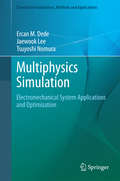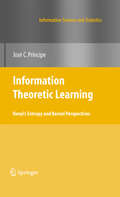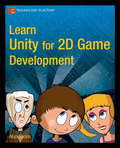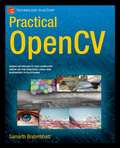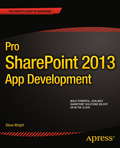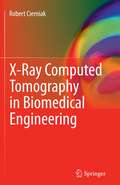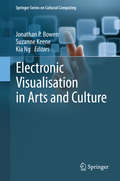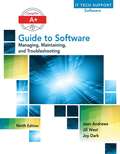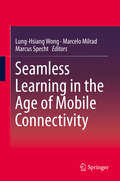- Table View
- List View
Games and Learning Alliance
by Alessandro De GloriaThis book constitutes the refereed proceedings of the Third International Conference on Games and Learning Alliance, GALA 2014, held in Bucharest, Romania, in July 2014. The 15 revised papers presented were carefully reviewed and selected from 26 submissions. The papers presented cover a variety of aspects and knowledge fields. They are grouped into four sessions: pedagogy, technology, design, and applications.
Engineering Embedded Systems
by Peter HintenausThis is a textbook for graduate and final-year-undergraduate computer-science and electrical-engineering students interested in the hardware and software aspects of embedded and cyberphysical systems design. It is comprehensive and self-contained, covering everything from the basics to case-study implementation. Emphasis is placed on the physical nature of the problem domain and of the devices used. The reader is assumed to be familiar on a theoretical level with mathematical tools like ordinary differential equation and Fourier transforms. In this book these tools will be put to practical use. Engineering Embedded Systems begins by addressing basic material on signals and systems, before introducing to electronics. Treatment of digital electronics accentuating synchronous circuits and including high-speed effects proceeds to micro-controllers, digital signal processors and programmable logic. Peripheral units and decentralized networks are given due weight. The properties of analog circuits and devices like filters and data converters are covered to the extent desirable by a systems architect. The handling of individual elements concludes with power supplies including regulators and converters. The final section of the text is composed of four case studies: * electric-drive control, permanent magnet synchronous motors in particular; * lock-in amplification with measurement circuits for weight and torque, and moisture; * design of a simple continuous wave radar that can be operated to measure speed and distance; and * design of a Fourier transform infrared spectrometer for process applications. End-of-chapter exercises will assist the student to assimilate the tutorial material and these are supplemented by a downloadable solutions manual for instructors. The "pen-and-paper" problems are further augmented with laboratory activities. In addition to its student market, Engineering Embedded Systems will assist industrial practitioners working in systems architecture and the design of electronic measurement systems to keep up to date with developments in embedded systems through self study.
Temperature- and Supply Voltage-Independent Time References for Wireless Sensor Networks
by Wim Dehaene Georges Gielen Valentijn De SmedtThis book investigates the possible circuit solutions to overcome the temperature and supply voltage-sensitivity of fully-integrated time references for ultra-low-power communication in wireless sensor networks. The authors provide an elaborate theoretical introduction and literature study to enable full understanding of the design challenges and shortcomings of current oscillator implementations. Furthermore, a closer look to the short-term as well as the long-term frequency stability of integrated oscillators is taken. Next, a design strategy is developed and applied to 5 different oscillator topologies and 1 sensor interface. All 6 implementations are subject to an elaborate study of frequency stability, phase noise and power consumption. In the final chapter all blocks are compared to the state of the art.
Multistate Analysis of Life Histories with R
by Frans WillekensThis book provides an introduction to multistate event history analysis. It is an extension of survival analysis, in which a single terminal event (endpoint) is considered and the time-to-event is studied. Multistate models focus on life histories or trajectories, conceptualized as sequences of states and sequences of transitions between states. Life histories are modeled as realizations of continuous-time Markov processes. The model parameters, transition rates, are estimated from data on event counts and populations at risk, using the statistical theory of counting processes. The Comprehensive R Network Archive (CRAN) includes several packages for multistate modeling. This book is about Biograph. The package is designed to (a) enhance exploratory analysis of life histories and (b) make multistate modeling accessible. The package incorporates utilities that connect to several packages for multistate modeling, including survival, eha, Epi, mvna etm, mstate, msm, and TraMineR for sequence analysis. The book is a 'hands-on' presentation of Biograph and the packages listed. It is written from the perspective of the user. To help the user master the techniques and the software, a single data set is used to illustrate the methods and software. It is the subsample of the German Life History Survey, which was also used by Blossfeld and Rohwer in their popular textbook on event history modeling. Another data set, the Netherlands Family and Fertility Survey, is used to illustrate how Biograph can assist in answering questions on life paths of cohorts and individuals. The book is suitable as a textbook for graduate courses on event history analysis and introductory courses on competing risks and multistate models. It may also be used as a self-study book. The R code used in the book is available online. Frans Willekens is affiliated with the Max Planck Institute for Demographic Research (MPIDR) in Rostock, Germany. He is Emeritus Professor of Demography at the University of Groningen, a Honorary Fellow of the Netherlands Interdisciplinary Demographic Institute (NIDI) in the Hague, and a Research Associate of the International Institute for Applied Systems Analysis (IIASA), Laxenburg, Austria. He is a member of Royal Netherlands Academy of Arts and Sciences (KNAW). He has contributed to the modeling and simulation of life histories, mainly in the context of population forecasting.
Towards the Internet of Services: The THESEUS Research Program
by Wolfgang Wahlster Hans-Joachim Grallert Stefan Wess Hermann Friedrich Thomas WidenkaThe Internet of Services and the Internet of Things are major building blocks of the Future Internet. The digital enterprise of the future is based not only on mobile, social, and cloud technologies, but also on semantic technologies and the future Internet of Everything. Semantic technologies now enable mass customization for the delivery of goods and services that meet individual customer needs and tastes with near mass production efficiency and reliability. This is creating a competitive advantage in the industrial economy, the service economy, and the emerging data economy, leading to smart products, smart services, and smart data, all adaptable to specific tasks, locations, situations, and contexts of smart spaces. Such technologies allow us to describe, revise, and adapt the characteristics, functions, processes, and usage patterns of customization targets on the basis of machine-understandable content representation that enables automated processing and information sharing between human and software agents. This book explains the principal achievements of the Theseus research program, one of the central programs in the German government's Digital 2015 initiative and its High-Tech Strategy 2020. The methods, toolsets, and standards for semantic technologies developed during this program form a solid basis for the fourth industrial revolution (Industrie 4. 0), the hybrid service economy, and the transformation of big data into useful smart data for the emerging data economy. The contributing authors are leading scientists and engineers, representing world-class academic and industrial research teams, and the ideas, technologies, and representative use cases they describe in the book derive from results in multidisciplinary fields, such as the Internet of Services; the Semantic Web, and semantic technologies, knowledge management, and search; user interfaces, multimodal interaction, and visualization; machine learning and data mining; and business process support, manufacturing, automation, medical systems, and integrated service engineering. The book will be of value to both researchers and practitioners in these domains.
State of the Art Applications of Social Network Analysis
by Tansel Özyer Fazli Can Faruk PolatSocial network analysis increasingly bridges the discovery of patterns in diverse areas of study as more data becomes available and complex. Yet the construction of huge networks from large data often requires entirely different approaches for analysis including; graph theory, statistics, machine learning and data mining. This work covers frontier studies on social network analysis and mining from different perspectives such as social network sites, financial data, e-mails, forums, academic research funds, XML technology, blog content, community detection and clique finding, prediction of user's- behavior, privacy in social network analysis, mobility from spatio-temporal point of view, agent technology and political parties in parliament. These topics will be of interest to researchers and practitioners from different disciplines including, but not limited to, social sciences and engineering.
Human-Centered Social Media Analytics
by Yun FuThis book provides a timely and unique survey of next-generation social computational methodologies. The text explains the fundamentals of this field, and describes state-of-the-art methods for inferring social status, relationships, preferences, intentions, personalities, needs, and lifestyles from human information in unconstrained visual data. Topics and features: includes perspectives from an international and interdisciplinary selection of pre-eminent authorities; presents balanced coverage of both detailed theoretical analysis and real-world applications; examines social relationships in human-centered media for the development of socially-aware video, location-based, and multimedia applications; reviews techniques for recognizing the social roles played by people in an event, and for classifying human-object interaction activities; discusses the prediction and recognition of human attributes via social media analytics, including social relationships, facial age and beauty, and occupation.
Software Engineering and Formal Methods
by Steve Counsell Manuel NúñezThis book constitutes the revised selected papers of the collocated workshops of the 11th International Conference on Software Engineering and Formal Methods, SEFM 2013, held in Madrid, Spain, in September 2013. The conference hosted 5 workshops: The Second International Workshop on Behavioural Types (BEAT2). The aim was to pursue research topics in the use of behavioural type theory as the basis for new foundations, programming languages and software development methods for communication-intensive distributed systems. The Third Workshop on Formal Methods in the Development of Software (WS-FMDS). The aim was to bring together scientists and practitioners active in the area of formal methods and interested in exchanging their experiences in the industrial usage of these methods. The Workshop on a Formal Methods Body of Knowledge for Railway Control and Safety Systems (FM-RAIL-BOK). In many engineering-based application areas such as in the railway domain, formal methods have reached a level of maturity that already enables the compilation of a so-called body of knowledge. The Second International Symposium on Modelling and Knowledge Management for Sustainable Development (MoKMaSD). The aim was to bring together researchers and practitioner from academia, industry, government and non-government organisations to present research results and exchange experience, ideas and solutions for modelling and analysing complex systems. In particular in areas including economy, governance, health, biology, ecology, climate and poverty reduction. The 7th International Workshop on Foundations and Techniques for Open Source Software Certification (Open Cert). The aim was to bring together researchers from Academia and Industry interested in the quality assessment of OSS projects, as well as the metrics, procedures and tools used in OSS communities and for the measurement and assessment of OSS quality.
Innovative Technologies in Urban Mapping
by Antonella Contin Paolo Paolini Rossella SalernoThe book presents a comprehensive vision of the impact of ICT on the contemporary city, heritage, public spaces and meta-cities on both urban and metropolitan scales, not only in producing innovative perspectives but also related to newly discovered scientific methods, which can be used to stimulate the emerging reciprocal relations between cities and information technologies. Using the principles established by multi-disciplinary interventions as examples and then expanding on them, this book demonstrates how by using ICT and new devices, metropolises can be organized for a future that preserves the historic nucleus of the city and the environment while preparing the necessary expansion of transportation, housing and industrial facilities.
Informatics in Control, Automation and Robotics
by Alain Bernard Oleg Gusikhin Kurosh Madani Jean-Louis FerrierThis book includes extended and revised versions of a set of selected papers from the Ninth International Conference on Informatics in Control Automation and Robotics (ICINCO 2012), held in Rome, Italy, from 28 to 31 July 2012. The conference was organized in four simultaneous tracks: Intelligent Control Systems and Optimization, Robotics and Automation, Systems Modeling, Signal Processing and Control and Industrial Engineering, Production and Management. ICINCO 2012 received 360 paper submissions, from 58 countries in all continents. From these, after a blind review process, only 40 were accepted as full papers, of which 20 were selected for inclusion in this book, based on the classifications provided by the Program Committee. The selected papers reflect the interdisciplinary nature of the conference as well as the logic equilibrium between the four abovementioned tracks. The diversity of topics is an important feature of this conference, enabling an overall perception of several important scientific and technological trends.
Preventive Methods for Coastal Protection: Towards the Use of Ocean Dynamics for Pollution Control
by Ewald Quak Tarmo SoomereThe aim of the book is to present for non-specialist researchers as well as for experts a comprehensive overview of the background, key ideas, basic methods, implementation details and a selection of solutions offered by a novel technology for the optimisation of the location of dangerous offshore activities in terms of environmental criteria, as developed in the course of the BalticWay project. The book consists of two parts. The first part introduces the basic principles of ocean modeling and depicts the long way from the generic principles to the practical modeling of oil spills and of the propagation of other adverse impacts. The second part focuses on the techniques for solving the inverse problem of the quantification of offshore areas with respect to their potential to serve as a source of environmental danger to vulnerable regions (such as spawning, nursing or also tourist areas). The chapters are written in a tutorial style; they are mostly self-contained and understandable for non-specialist researchers and students. They are carefully peer-reviewed by international experts. The goal was to produce a book that highlights all key steps, methods, models and data sets it is necessary to combine in order to produce a practically usable technology and/or decision support system for a particular sea region. Thus the book is useful not only as a description and a manual of this particular technology but also as a roadmap highlighting the complicated technical issues of ocean modeling for practical purposes. It describes the approaches taken by the authors in an understandable way and thus is useful for educational purposes, such as a course in industrially and environmentally relevant applications of ocean modeling.
Discrete Calculus
by Leo J. Grady Jonathan R. PolimeniThe field of discrete calculus, also known as "discrete exterior calculus", focuses on finding a proper set of definitions and differential operators that make it possible to operate the machinery of multivariate calculus on a finite, discrete space. In contrast to traditional goals of finding an accurate discretization of conventional multivariate calculus, discrete calculus establishes a separate, equivalent calculus that operates purely in the discrete space without any reference to an underlying continuous process. This unique text brings together into a single framework current research in the three areas of discrete calculus, complex networks, and algorithmic content extraction. Although there have been a few intersections in the literature between these disciplines, they have developed largely independently of one another, yet researchers working in any one of these three areas can strongly benefit from the tools and techniques being used in the others. Many example applications from several fields of computational science are provided to demonstrate the usefulness of this framework to a broad range of problems. Readers are assumed to be familiar with the basics of vector calculus, graph theory, and linear algebra. Topics and features: presents a thorough review of discrete calculus, with a focus on key concepts required for successful application; unifies many standard image processing algorithms into a common framework for viewing a wide variety of standard algorithms in filtering, clustering, and manifold learning that may be applied to processing data associated with a graph or network; explains how discrete calculus provides a natural definition of "low-frequency" on a graph, which then yields filtering and denoising algorithms; discusses how filtering algorithms can give rise to clustering algorithms, which can be used to develop manifold learning and data discovery methods; examines ranking algorithms, as well as algorithms for analyzing the structure of a network. Graduate students and researchers interested in discrete calculus, complex networks, image processing and computer graphics will find this text/reference a clear introduction to the foundations of discrete calculus as well as a useful guide to have readily available for their work. Dr. Leo J. Grady is a Senior Research Scientist with Siemens Corporate Research in Princeton, New Jersey, USA. Dr. Jonathan R. Polimeni is a Research Fellow at the Massachusetts General Hospital in Boston, Massachusetts, USA, and Instructor in Radiology at Harvard Medical School, Boston, Massachusetts, USA.
RNA Bioinformatics
by Ernesto PicardiThis volume provides an overview of RNA bioinformatics methodologies, including basic strategies to predict secondary and tertiary structures, and novel algorithms based on massive RNA sequencing. Interest in RNA bioinformatics has rapidly increased thanks to the recent high-throughput sequencing technologies allowing scientists to investigate complete transcriptomes at single nucleotide resolution. Adopting advanced computational technics, scientists are now able to conduct more in-depth studies and present them to you in this book. Written in the highly successful Methods of Molecular Biology series format, chapters include introductions to their respective topics, lists of the necessary materials and equipment, step-by-step, readily reproducible bioinformatics protocols, and key tips to avoid known pitfalls. Authoritative and practical, RNA Bioinformatics seeks to aid scientists in the further study of bioinformatics and computational biology of RNA.
DevOps on the Microsoft Stack
by Wouter De KortThis book tells you everything you need to know to help your organization implement DevOps on the Microsoft platform. You will learn how to use Visual Studio, Visual Studio Team Services, and Azure to implement a complete DevOps process in your company. You will learn about Agile Project Management, Continuous Integration, Continuous Delivery, Technical Debt Management, Automatic Testing and Monitoring, and see how all these areas fit together. DevOps is important for organizations that want to make the best use of their resources and avoid costly mistakes. Teams that embrace DevOps deploy code up to 30 times more frequently than their competition and less than 50% of their deployments fail according to Puppet Labs State of DevOps survey. DevOps on the Microsoft Stack shows you how to help your organization implement DevOps, covering the tooling they will need and how to make everything work together while following best practices. The focus is not only on technology but also on the cultural issues that teams will face when implementing DevOps. The author's goal is to not only show you which tooling there is but help you to successfully use everything together to implement DevOps in your projects and organization. What you'll learn What DevOps is and how it can help development teams How to use Visual Studio, Visual Studio Team Services, and Azure to setup a DevOps process How to introduce DevOps to your organization and how to overcome problems Who this book is for This book is for experienced developers, lead developers and architects using the Microsoft platform who are looking for ways to use Team Foundation Server and Visual Studio Online more effectively in their organization.
Waves in Neural Media
by Paul C. BressloffWaves in Neural Media: From Single Neurons to Neural Fields surveys mathematical models of traveling waves in the brain, ranging from intracellular waves in single neurons to waves of activity in large-scale brain networks. The work provides a pedagogical account of analytical methods for finding traveling wave solutions of the variety of nonlinear differential equations that arise in such models. These include regular and singular perturbation methods, weakly nonlinear analysis, Evans functions and wave stability, homogenization theory and averaging, and stochastic processes. Also covered in the text are exact methods of solution where applicable. Historically speaking, the propagation of action potentials has inspired new mathematics, particularly with regard to the PDE theory of waves in excitable media. More recently, continuum neural field models of large-scale brain networks have generated a new set of interesting mathematical questions with regard to the solution of nonlocal integro-differential equations. Advanced graduates, postdoctoral researchers and faculty working in mathematical biology, theoretical neuroscience, or applied nonlinear dynamics will find this book to be a valuable resource. The main prerequisites are an introductory graduate course on ordinary differential equations or partial differential equations, making this an accessible and unique contribution to the field of mathematical biology.
Essential Statistical Inference
by Dennis D. Boos L A StefanskiThis book is for students and researchers who have had a first year graduate level mathematical statistics course. It covers classical likelihood, Bayesian, and permutation inference; an introduction to basic asymptotic distribution theory; and modern topics like M-estimation, the jackknife, and the bootstrap. R code is woven throughout the text, and there are a large number of examples and problems. An important goal has been to make the topics accessible to a wide audience, with little overt reliance on measure theory. A typical semester course consists of Chapters 1-6 (likelihood-based estimation and testing, Bayesian inference, basic asymptotic results) plus selections from M-estimation and related testing and resampling methodology. Dennis Boos and Len Stefanski are professors in the Department of Statistics at North Carolina State. Their research has been eclectic, often with a robustness angle, although Stefanski is also known for research concentrated on measurement error, including a co-authored book on non-linear measurement error models. In recent years the authors have jointly worked on variable selection methods.
Multiphysics Simulation
by Ercan M. Dede Jaewook Lee Tsuyoshi NomuraThis book highlights a unique combination of numerical tools and strategies for handling the challenges of multiphysics simulation, with a specific focus on electromechanical systems as the target application. Features: introduces the concept of design via simulation, along with the role of multiphysics simulation in today's engineering environment; discusses the importance of structural optimization techniques in the design and development of electromechanical systems; provides an overview of the physics commonly involved with electromechanical systems for applications such as electronics, magnetic components, RF components, actuators, and motors; reviews the governing equations for the simulation of related multiphysics problems; outlines relevant (topology and parametric size) optimization methods for electromechanical systems; describes in detail several multiphysics simulation and optimization example studies in both two and three dimensions, with sample numerical code.
Information Theoretic Learning
by Jose C. PrincipeThis book presents the first cohesive treatment of Information Theoretic Learning (ITL) algorithms to adapt linear or nonlinear learning machines both in supervised or unsupervised paradigms. ITL is a framework where the conventional concepts of second order statistics (covariance, L2 distances, correlation functions) are substituted by scalars and functions with information theoretic underpinnings, respectively entropy, mutual information and correntropy. ITL quantifies the stochastic structure of the data beyond second order statistics for improved performance without using full-blown Bayesian approaches that require a much larger computational cost. This is possible because of a non-parametric estimator of Renyi's quadratic entropy that is only a function of pairwise differences between samples. The book compares the performance of ITL algorithms with the second order counterparts in many engineering and machine learning applications. Students, practitioners and researchers interested in statistical signal processing, computational intelligence, and machine learning will find in this book the theory to understand the basics, the algorithms to implement applications, and exciting but still unexplored leads that will provide fertile ground for future research.
Learn Unity for 2D Game Development
by Alan Thorn2D games are everywhere, from mobile devices and websites to game consoles and PCs. Timeless and popular, 2D games represent a substantial segment of the games market. In Learn Unity for 2D Game Development, targeted at both game development newcomers and established developers, experienced game developer Alan Thorn shows you how to use the powerful Unity engine to create fun and imaginative 2D games. Written in clear and accessible language, Learn Unity for 2D Game Development will show you how to set up a step-by-step 2D workflow in Unity, how to build and import textures, how to configure and work with cameras, how to establish pixel-perfect ratios, and all of this so you can put that infrastructure to work in a real, playable game. Then the final chapters show you how to put what you've already made to work in creating a card-matching game, plus you'll learn how to optimize your game for mobile devices. What you'll learn How to create a 2D workflow in Unity Customizing the Unity Editor How to generate atlas textures and textured quads Animation effects and camera configuration Handling user input Creating a game from start to finish Optimizing for mobile devices Who this book is for Game development students and professionals, indie developers, game artists and designers, and Unity developers looking to improve their workflow and effectiveness. Table of Contents 1. Unity Basics for 2D Games 2. Materials and Textures 3. Quick 2D Workflow 4. Customizing the Editor with Editor Classes 5. Procedural Geometry and Textured Quads 6. Generating Atlas Textures 7. UVs and Animation 8. Cameras and Pixel Perfection 9. Input for 2D Games 10. Getting Started with a 2D Game 11. Completing the 2D Card Game 12. Optimization 13. Wrapping Things Up
Practical OpenCV
by Samarth BrahmbhattPractical OpenCV is a hands-on project book that shows you how to get the best results from OpenCV, the open-source computer vision library. Computer vision is key to technologies like object recognition, shape detection, and depth estimation. OpenCV is an open-source library with over 2500 algorithms that you can use to do all of these, as well as track moving objects, extract 3D models, and overlay augmented reality. It's used by major companies like Google (in its autonomous car), Intel, and Sony; and it is the backbone of the Robot Operating System's computer vision capability. In short, if you're working with computer vision at all, you need to know OpenCV. With Practical OpenCV, you'll be able to: Get OpenCV up and running on Windows or Linux. Use OpenCV to control the camera board and run vision algorithms on Raspberry Pi. Understand what goes on behind the scenes in computer vision applications like object detection, image stitching, filtering, stereo vision, and more. Code complex computer vision projects for your class/hobby/robot/job, many of which can execute in real time on off-the-shelf processors. Combine different modules that you develop to create your own interactive computer vision app. "
Pro SharePoint 2013 App Development
by Steve WrightApps have taken the world by storm, and now they're taking SharePoint as well. The biggest new thing in SharePoint 2013, apps are the solution to creating custom code that runs on not just your own SharePoint deployment, but also on others' implementations as well. Pro SharePoint 2013 App Development is your must-have guide to developing app solutions that run on the SharePoint 2013 platform. Using step-by-step tutorials, authorSteve Wrightcreates a sample SharePoint app throughout the course of the book, and you can walk with him through the entire lifecycle of a SharePoint app. Get expert guidance and advice on creating an app, provisioning it for use in SharePoint, securing it from unauthorized use and from other applications, integratingyour app with SharePoint search and other platform features, and much more. You'll even discover how to present your app to users on mobile devices like iPads, smartphones, and Microsoft Surface tablets. Apps in SharePoint are here to stay. Don't miss out - pick up a copy of Pro SharePoint 2013 App Development and get started on your own custom apps today. Introduces the architecture for creating and hosting SharePoint apps. Leads the reader through the creation and deployment of a complete solution. Provides an understanding of the security features in the SharePoint app model. Helps the organization leverage internal data securely over the network. Leverages SharePoint search and other services to create rich SharePoint solutions. Introduces the techniques for delivering data on a multitude of web and mobile platforms. "
X-Ray Computed Tomography in Biomedical Engineering
by Robert CierniakComputed Tomography gives a detailed overview of various aspects of computed tomography. It discusses X-ray CT tomography from a historical point of view, the design and physical operating principles of computed tomography apparatus, the algorithms of image reconstruction and the quality assessment criteria of tomography scanners. Algorithms of image reconstruction from projections, a crucial problem in medical imaging, are considered in depth. The author gives descriptions of the reconstruction methods related to tomography scanners with a parallel X-ray beam, trough solutions with fan-shaped beam and successive modifications of spiral scanners. Computed Tomography contains a dedicated chapter for those readers who are interested in computer simulations based on studies of reconstruction algorithms. The information included in this chapter will enable readers to create a simulation environment in which virtual tomography projections can be obtained in all basic projection systems. This monograph is a valuable study on computed tomography that will be of interest to advanced students and researchers in the fields of biomedical engineering, medical electronics, computer science and medicine.
Electronic Visualisation in Arts and Culture
by Jonathan P. Bowen Kia Ng Suzanne KeenePresenting the latest technological developments in arts and culture, this volume demonstrates the advantages of a union between art and science. Electronic Visualisation in Arts and Culture is presented in five parts: Imaging and CultureNew Art PracticeSeeing MotionInteraction and Interfaces Visualising HeritageElectronic Visualisation in Arts and Culture explores a variety of new theory and technologies, including devices and techniques for motion capture for music and performance, advanced photographic techniques, computer generated images derived from different sources, game engine software, airflow to capture the motions of bird flight and low-altitude imagery from airborne devices. The international authors of this book are practising experts from universities, art practices and organisations, research centres and independent research. They describe electronic visualisation used for such diverse aspects of culture as airborne imagery, computer generated art based on the autoimmune system, motion capture for music and for sign language, the visualisation of time and the long term preservation of these materials. Selected from the EVA London conferences from 2009-2012, held in association with the Computer Arts Society of the British Computer Society, the authors have reviewed, extended and fully updated their work for this state-of-the-art volume.
Comp TIA A+ Guide to Software: Managing, Maintaining, and Troubleshooting
by Jean Andrews Joy Dark Jill WestThis step-by-step, highly visual text provides a comprehensive introduction to managing and maintaining computer hardware and software. Written by best-selling author and educator Jean Andrews, A+ Guide to Software, Ninth Edition closely integrates the CompTIA A+ Exam objectives to prepare students for the 220-902 certification exam. The new Ninth Edition also features extensive updates to reflect current technology, techniques, and industry standards in the dynamic, fast-paced field of PC repair and information technology. Each chapter covers both core concepts and advanced topics, organizing material to facilitate practical application and encourage students to learn by doing. The new edition features more coverage of security, virtualization, new coverage of cloud computing, Linux and Mac OS, and increased emphasis on mobile devices. Supported by a wide range of supplemental resources to enhance learning with Lab Manuals, CourseNotes, online labs and the optional MindTap that includes labs, certification test prep and interactive exercises and activities, this proven text offers students an ideal way to prepare for success as a professional IT support technician.
Seamless Learning in the Age of Mobile Connectivity
by Lung-Hsiang Wong Marcelo Milrad Marcus SpechtThe book departs from the approach of related titles by focusing on describing and reflecting upon the notion of seamless learning with regard to salient characteristics of learner mobility and bridging of learning experiences across learning spaces. It is the first such work that is solely dedicated to research on and the practice of seamless learning, uniquely combining interpretations, visions, and past research on and practices in seamless learning from diversified perspectives. The book also strikes a good balance between theoretical and practical perspectivess, going beyond a collection of reports on specific research projects. Instead of thick descriptions of research processes and findings, readers will find significant insights and food for thought intended to inspire further advances in the research on and practice of seamless learning.
